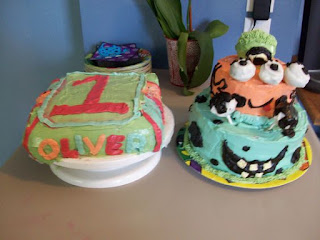One of the Wolf River apple seeds we planted around November/December 2008 became a fruit-producing tree for the first time at age 6 last summer (2015)!
By the way, I think these are legitimate heirloom apples because Wolf River is an old variety itself and the apple from which we took the seed was handed to us by a family member who brought the apple back from the old tree on another family member's long-standing farm.
For a full recap of our apple trees up to this point, click here. Picking up from there, the two trees we planted in our front yard have grown taller than our porch roof, and one of them is now producing apples for the second year in a row following heavy pruning. Here's a snapshot of this year's apples growing amid the brambly branches:
And, there's hope for our two other trees. The other one out front bore its first blossom—just one—this spring. It's too leafy up there for us to see if that blossom became a fruit, but regardless, it's a sign the tree is not sterile. The third tree now has a permanent home in our backyard where there used to be an ash tree. Most of the ash trees in our area have been cut down and removed due to the emerald ash borer infestation, and one day we looked out our window and realized our own ash tree was a stump! Upsetting, but it provided an opening for that last apple tree. It is smaller than the other two, having spent an extra season confined to a pot, but it grows a lot each summer now that it has room to stretch.
As is typical for apple offspring, the apples we got from our tree are not identical to the Wolf River variety that produced the seed that sprouted this tree. They are hefty apples like Wolf Rivers ("one apple, one pie"), though not quite as huge, and they have same the mixed red and green peel, but we thought their texture was a bit mealier and their flavor not quite the same pleasantly sweet-tart flavor of the parent apple.
Then again, it has been nearly seven years since I tasted a Wolf River apple from the cousins' tree in Wisconsin. After reading the following excerpt from Words to Eat By: Five Foods and the Culinary History of the English Language by Ina Lipkowitz (St. Martin's, 2011), which pretty much describes our apples other than the extreme size, I'm thinking they might bear more resemblance than we initially thought.
"By modern commercial standards," writes Edward Behr, "the old varieties often have shortcomings. They may bruise easily, store poorly, be plain-looking or outright ugly... An orchadist who still has some Wolf River trees told me, 'It's probably about the poorest apple I grow.' " And yet Wolf River apples as big as grapefruits or small cantaloupes (they often weigh more than a pound each) with dull red skin, coarsely textured flesh, and a tart flavor, have become so popular that hundred [sic] of Web sites sell seeds and offer such cooking tips as "One apple, one pie." (18)
I believe a parent-offspring apple taste test is in order.




















